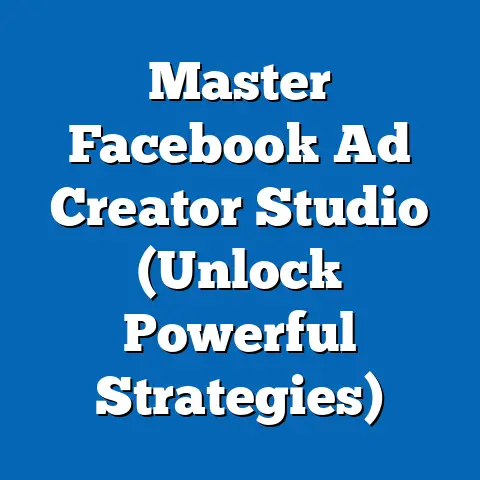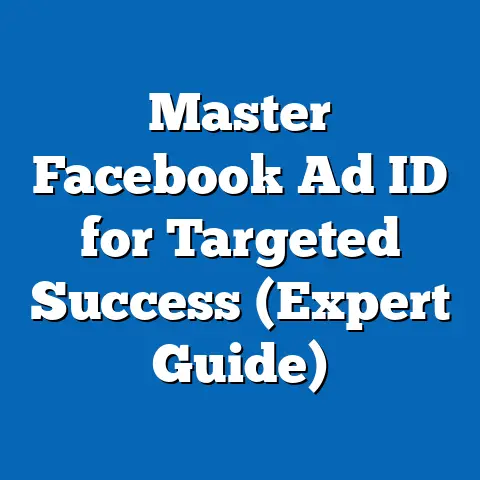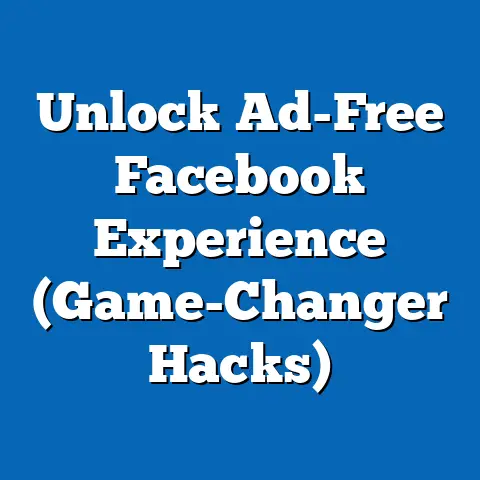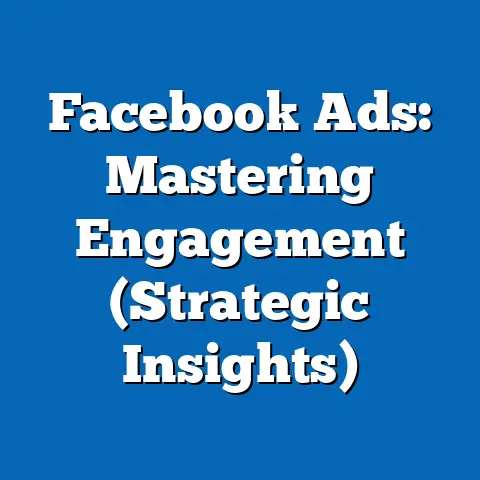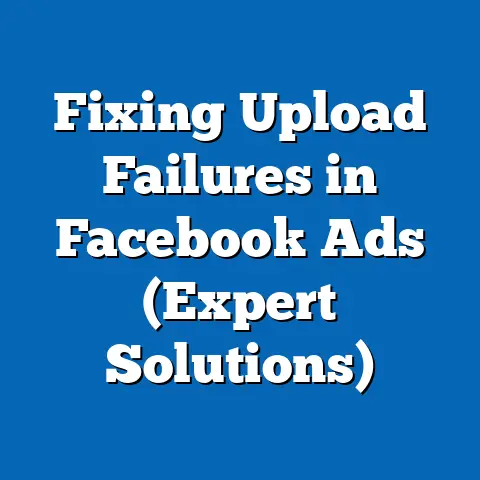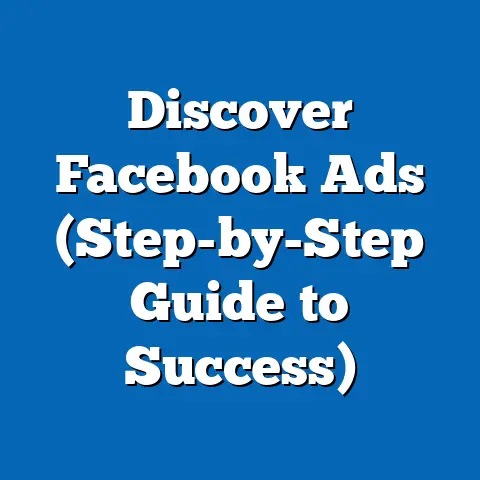Elevate Brand with Facebook Stories Ads (Pro Strategies)
In a digital landscape where attention spans are shorter than ever and competition is fierce, how can brands effectively capture their audience’s interest and stand out? The answer, in my experience, lies in embracing innovative advertising formats that resonate with consumers in real time. Enter Facebook Stories Ads—a dynamic, immersive way to engage users on one of the world’s largest social media platforms. I’ve seen firsthand how these ads can transform a brand’s presence, and in this article, I’ll explore how you can leverage Facebook Stories Ads to elevate your brand and forge deeper connections with your audience.
My First Encounter with the Power of Stories Ads
I remember when I first started experimenting with Facebook Stories Ads for a local coffee shop. We were struggling to reach a younger demographic, and traditional Facebook ads just weren’t cutting it. The moment we launched our first Stories Ad – a short, visually appealing clip showcasing our iced latte on a hot summer day – we saw a significant spike in foot traffic from the 18-25 age group. That’s when I realized the untapped potential of this ad format.
1. Understanding Facebook Stories Ads
Facebook Stories Ads have become a powerhouse in the digital advertising world. They offer a unique way to connect with audiences in a format that feels more personal and less intrusive than traditional ads. Let’s dive into what makes them so effective.
Definition and Overview of Facebook Stories Ads
Facebook Stories Ads are full-screen, vertical video or image ads that appear between users’ organic Stories on Facebook. Unlike regular News Feed ads, Stories Ads are designed to be immersive and engaging, mimicking the organic content users are already consuming. They disappear after 24 hours, creating a sense of urgency and encouraging immediate action.
From my experience, the ephemeral nature of Stories Ads is a key factor in their success. Users are more likely to pay attention to content that they know won’t be around for long, making it a prime opportunity to capture their attention.
Statistics Highlighting the Growth and Effectiveness of Stories Ads
The numbers don’t lie: Stories Ads are a force to be reckoned with. Here are some key statistics that highlight their growth and effectiveness:
- Over 500 million people use Facebook Stories every day. This massive audience provides a huge potential reach for advertisers.
- 62% of people say they have become more interested in a brand or product after seeing it in a Story. This demonstrates the power of Stories Ads to drive brand awareness and consideration. (Source: Facebook IQ)
- Stories Ads have a higher click-through rate (CTR) than traditional News Feed ads in some industries. The immersive format and engaging content can lead to more clicks and conversions.
- Brands are increasingly allocating more of their ad budget to Stories. As the effectiveness of Stories Ads becomes more apparent, marketers are shifting their budgets accordingly.
These statistics underscore the importance of incorporating Facebook Stories Ads into your advertising strategy. The potential reach and engagement are simply too significant to ignore.
Differences Between Facebook Stories Ads and Traditional Ad Formats
While both Facebook Stories Ads and traditional News Feed ads serve the same purpose – to promote your brand – they differ significantly in terms of format, user experience, and effectiveness. Here’s a breakdown of the key differences:
| Feature | Facebook Stories Ads | Traditional News Feed Ads |
|---|---|---|
| Format | Full-screen, vertical video or image | Horizontal or square images/videos with text captions |
| User Experience | Immersive, feels like organic content | More intrusive, feels like an advertisement |
| Lifespan | Disappears after 24 hours | Remains visible until manually removed or archived |
| Engagement | Higher engagement rates, more personal connection | Lower engagement rates, more formal interaction |
| Call-to-Action | Swipe up or tap to learn more | Clickable buttons and links |
| Feature | Facebook Stories Ads | Traditional News Feed Ads |
|---|---|---|
| Format | Full-screen, vertical video or image | Horizontal or square images/videos with text captions |
| User Experience | Immersive, feels like organic content | More intrusive, feels like an advertisement |
| Lifespan | Disappears after 24 hours | Remains visible until manually removed or archived |
| Engagement | Higher engagement rates, more personal connection | Lower engagement rates, more formal interaction |
| Call-to-Action | Swipe up or tap to learn more | Clickable buttons and links |
In my experience, Stories Ads are particularly effective for capturing the attention of younger audiences who are more active on mobile devices and prefer visually engaging content. Traditional News Feed ads, on the other hand, may be better suited for reaching older demographics or for conveying more detailed information.
Key Takeaway: Facebook Stories Ads offer a unique and effective way to reach audiences on mobile devices. Their immersive format and engaging content can lead to higher engagement rates and a more personal connection with your brand.
Next Steps: Consider how you can incorporate Facebook Stories Ads into your existing advertising strategy. Start by experimenting with different formats and targeting options to see what works best for your brand.
2. The Importance of Visual Storytelling
In the age of digital overload, visual storytelling is more critical than ever. It’s not enough to simply show your product or service; you need to tell a compelling story that resonates with your audience on an emotional level.
The Psychology Behind Storytelling in Advertising
Humans are wired for stories. From ancient cave paintings to modern-day movies, stories have always been a fundamental part of our culture and communication. When we hear a story, our brains release dopamine, a neurotransmitter associated with pleasure and motivation. This makes us more likely to pay attention, remember the message, and take action.
I’ve always believed that the best ads are the ones that don’t feel like ads at all. They’re stories that capture our imagination, make us laugh, or tug at our heartstrings. And when you can achieve that, you’ve created a powerful connection with your audience.
How Visual Elements Enhance Engagement and Retention
Visual elements play a crucial role in storytelling. They can evoke emotions, create a sense of atmosphere, and make complex information easier to understand. Here are some ways visual elements enhance engagement and retention:
- Grabbing Attention: Eye-catching visuals can instantly grab the viewer’s attention and prevent them from scrolling past your ad.
- Conveying Emotion: Visuals can convey emotions and create a connection with the viewer on a deeper level.
- Simplifying Information: Visuals can simplify complex information and make it easier to understand.
- Enhancing Memory: Visuals are more memorable than text alone.
In my experience, the key is to use visuals that are authentic and relevant to your brand. Don’t just use stock photos or generic videos. Instead, create content that reflects your brand’s personality and values.
Case Studies Showcasing Successful Visual Storytelling Through Facebook Stories Ads
Let’s take a look at some real-world examples of brands that have successfully utilized visual storytelling through Facebook Stories Ads:
- Airbnb: Airbnb often uses Stories Ads to showcase unique and inspiring travel experiences. Their ads feature stunning visuals of exotic destinations and personal stories from travelers, creating a sense of wanderlust and encouraging viewers to book their next adventure.
- GoPro: GoPro is known for its action-packed videos that capture the thrill of extreme sports and outdoor adventures. Their Stories Ads feature breathtaking footage shot by GoPro users, showcasing the capabilities of their cameras and inspiring viewers to capture their own adventures.
- Nike: Nike uses Stories Ads to tell inspiring stories of athletes overcoming challenges and achieving their goals. Their ads feature powerful visuals and motivational messages, creating a connection with viewers on an emotional level and encouraging them to pursue their own athletic dreams.
These case studies demonstrate the power of visual storytelling to engage audiences, build brand loyalty, and drive conversions.
Key Takeaway: Visual storytelling is essential for creating engaging and memorable Facebook Stories Ads. Use visuals that are authentic, relevant, and emotionally resonant to connect with your audience on a deeper level.
Next Steps: Brainstorm ideas for visual stories that you can tell through your Facebook Stories Ads. Consider using a mix of videos, images, and animations to create a dynamic and engaging experience.
3. Crafting Compelling Content for Stories Ads
Creating compelling content for Stories Ads is an art and a science. It requires a deep understanding of your audience, a creative vision, and a willingness to experiment.
Key Components of an Effective Stories Ad (Visuals, Messaging, Call-to-Action)
An effective Stories Ad consists of three key components:
- Visuals: Eye-catching visuals are essential for grabbing the viewer’s attention and preventing them from scrolling past your ad.
- Messaging: Concise and compelling messaging is crucial for conveying your brand’s message and persuading viewers to take action.
- Call-to-Action: A clear and compelling call-to-action (CTA) is necessary for guiding viewers towards the desired outcome, whether it’s visiting your website, making a purchase, or signing up for your newsletter.
In my experience, the most successful Stories Ads are the ones that seamlessly integrate these three components. The visuals, messaging, and CTA should work together to create a cohesive and engaging experience.
Tips for Creating Eye-Catching Visuals and Concise Messaging
Here are some tips for creating eye-catching visuals and concise messaging for your Stories Ads:
- Use High-Quality Images and Videos: Ensure that your visuals are sharp, well-lit, and visually appealing.
- Keep it Short and Sweet: Stories Ads are designed to be consumed quickly, so keep your messaging concise and to the point.
- Use Text Overlays: Add text overlays to your visuals to highlight key messages and CTAs.
- Use Motion Graphics: Motion graphics can add a dynamic and engaging element to your Stories Ads.
- Use Humor: Humor can be a powerful tool for capturing attention and creating a connection with your audience.
- Focus on Benefits: Highlight the benefits of your product or service rather than just its features.
- Create a Sense of Urgency: Use words like “limited time offer” or “shop now” to create a sense of urgency and encourage immediate action.
I’ve found that testing different visuals and messaging is crucial for optimizing your Stories Ads. Don’t be afraid to experiment and see what works best for your audience.
The Role of User-Generated Content and Authentic Brand Voice
User-generated content (UGC) can be a powerful tool for creating authentic and engaging Stories Ads. UGC is content created by your customers or fans, such as photos, videos, and testimonials.
Here are some benefits of using UGC in your Stories Ads:
- Authenticity: UGC is perceived as more authentic and trustworthy than branded content.
- Social Proof: UGC provides social proof that your product or service is valuable and worthwhile.
- Cost-Effective: UGC can be a cost-effective way to create high-quality content.
- Engagement: UGC can increase engagement by featuring real people using your product or service.
In addition to using UGC, it’s important to maintain an authentic brand voice in your Stories Ads. Your brand voice should reflect your brand’s personality, values, and target audience.
Key Takeaway: Crafting compelling content for Stories Ads requires a deep understanding of your audience, a creative vision, and a willingness to experiment. Use high-quality visuals, concise messaging, and a clear call-to-action to create engaging and effective ads.
Next Steps: Create a content calendar for your Stories Ads. Plan out the visuals, messaging, and CTAs that you’ll use in each ad. Consider incorporating UGC and maintaining an authentic brand voice.
4. Targeting the Right Audience
Targeting the right audience is crucial for maximizing the impact of your Facebook Stories Ads. If you’re showing your ads to the wrong people, you’re wasting your time and money.
Utilizing Facebook’s Robust Targeting Options for Stories Ads
Facebook offers a wide range of targeting options that allow you to reach specific demographics, interests, behaviors, and locations. Here are some of the most commonly used targeting options:
- Demographics: Target users based on age, gender, education, relationship status, and job title.
- Interests: Target users based on their interests, hobbies, and passions.
- Behaviors: Target users based on their online behavior, such as purchase history, travel habits, and device usage.
- Locations: Target users based on their geographic location, such as country, region, city, or zip code.
- Custom Audiences: Create custom audiences based on your existing customer data, such as email lists, website visitors, and app users.
- Lookalike Audiences: Create lookalike audiences based on your custom audiences, allowing you to reach new users who are similar to your existing customers.
In my experience, the key to effective targeting is to combine multiple targeting options to create a highly specific audience. For example, you might target women aged 25-34 who are interested in fashion and live in New York City.
Audience Segmentation Strategies for Maximum Impact
Audience segmentation is the process of dividing your target audience into smaller groups based on shared characteristics. This allows you to create more personalized and relevant ads for each segment.
Here are some common audience segmentation strategies:
- Demographic Segmentation: Segment your audience based on age, gender, education, income, and other demographic factors.
- Geographic Segmentation: Segment your audience based on their location, such as country, region, city, or zip code.
- Behavioral Segmentation: Segment your audience based on their online behavior, such as purchase history, website visits, and app usage.
- Psychographic Segmentation: Segment your audience based on their values, attitudes, and lifestyle.
By segmenting your audience, you can create more targeted and effective Stories Ads that resonate with each segment.
The Importance of Testing and Refining Audience Targets
Testing and refining your audience targets is essential for optimizing your Stories Ads. You can use A/B testing to compare the performance of different audience targets and identify the ones that are most effective.
Here are some tips for testing and refining your audience targets:
- Start with a Broad Audience: Begin by targeting a broad audience and gradually narrow it down based on performance.
- Test Different Targeting Options: Experiment with different targeting options to see what works best for your brand.
- Use A/B Testing: Use A/B testing to compare the performance of different audience targets.
- Monitor Your Results: Monitor your results closely and make adjustments as needed.
I’ve found that it’s important to be patient and persistent when testing and refining your audience targets. It takes time to find the right combination of targeting options that will deliver the best results.
Key Takeaway: Targeting the right audience is crucial for maximizing the impact of your Facebook Stories Ads. Utilize Facebook’s robust targeting options, segment your audience, and test and refine your audience targets to optimize your results.
Next Steps: Identify your target audience and create audience segments based on shared characteristics. Use Facebook’s targeting options to reach your target audience and test different audience targets to optimize your results.
5. Leveraging Analytics and Insights
Data is your friend when it comes to Facebook Stories Ads. Understanding your analytics and insights is critical for optimizing your campaigns and achieving your goals.
Understanding Facebook Insights and Key Performance Indicators for Stories Ads
Facebook Insights provides a wealth of data about your Stories Ads performance. Here are some key performance indicators (KPIs) that you should be tracking:
- Reach: The number of unique users who saw your ad.
- Impressions: The number of times your ad was displayed.
- Click-Through Rate (CTR): The percentage of users who clicked on your ad.
- Cost Per Click (CPC): The average cost you paid for each click on your ad.
- Conversion Rate: The percentage of users who completed a desired action, such as making a purchase or signing up for your newsletter.
- Return on Ad Spend (ROAS): The amount of revenue you generated for every dollar you spent on advertising.
In my experience, it’s important to track these KPIs over time to identify trends and patterns. This will help you understand what’s working and what’s not, and make adjustments accordingly.
How to Analyze Ad Performance and Make Data-Driven Decisions
Analyzing your ad performance involves more than just looking at the numbers. You need to understand the context behind the data and draw meaningful conclusions.
Here are some tips for analyzing your ad performance:
- Look for Trends: Identify trends and patterns in your data over time.
- Compare Different Campaigns: Compare the performance of different campaigns to see what’s working best.
- Segment Your Data: Segment your data by demographics, interests, and other factors to identify specific audiences that are responding well to your ads.
- Use A/B Testing: Use A/B testing to compare the performance of different ad creatives, targeting options, and bidding strategies.
Based on your analysis, you can make data-driven decisions about how to optimize your campaigns. For example, if you see that your CTR is low, you might try experimenting with different ad creatives or targeting options.
Adjusting Campaigns Based on Analytics for Continuous Improvement
Continuous improvement is essential for maximizing the impact of your Facebook Stories Ads. You should be constantly monitoring your results, analyzing your data, and making adjustments to your campaigns.
Here are some adjustments you might consider making:
- Adjust Your Budget: Increase your budget for campaigns that are performing well and decrease your budget for campaigns that are not.
- Adjust Your Targeting: Refine your targeting options to reach a more specific audience.
- Adjust Your Ad Creatives: Experiment with different ad creatives to see what resonates best with your audience.
- Adjust Your Bidding Strategy: Experiment with different bidding strategies to optimize your cost per click and conversion rate.
I’ve found that the most successful advertisers are the ones who are constantly learning and adapting. They’re not afraid to experiment and try new things, and they’re always looking for ways to improve their results.
Key Takeaway: Leveraging analytics and insights is crucial for optimizing your Facebook Stories Ads. Track key performance indicators, analyze your ad performance, and adjust your campaigns based on data to achieve continuous improvement.
Next Steps: Set up Facebook Insights and track your key performance indicators. Analyze your ad performance and make data-driven decisions about how to optimize your campaigns.
6. Integrating Facebook Stories Ads into Your Overall Marketing Strategy
Facebook Stories Ads shouldn’t exist in a vacuum. To truly maximize their potential, you need to integrate them into your overall marketing strategy.
How Stories Ads Fit into the Broader Marketing Funnel
Stories Ads can play a role at every stage of the marketing funnel:
- Awareness: Stories Ads can be used to increase brand awareness and reach new audiences.
- Consideration: Stories Ads can be used to showcase your product or service and persuade potential customers to consider it.
- Conversion: Stories Ads can be used to drive conversions, such as sales, leads, and sign-ups.
- Loyalty: Stories Ads can be used to build brand loyalty and encourage repeat purchases.
In my experience, it’s important to tailor your Stories Ads to the specific stage of the marketing funnel. For example, if you’re trying to increase brand awareness, you might focus on creating visually appealing ads that showcase your brand’s personality and values. If you’re trying to drive conversions, you might focus on creating ads that highlight the benefits of your product or service and include a clear call-to-action.
Examples of Multi-Channel Campaigns That Incorporate Stories Ads
Here are some examples of multi-channel campaigns that incorporate Stories Ads:
- Email Marketing: Use Stories Ads to promote your email newsletter and encourage users to sign up.
- Social Media: Use Stories Ads to drive traffic to your other social media channels.
- Website: Use Stories Ads to drive traffic to your website and showcase your products or services.
- Influencer Marketing: Partner with influencers to create Stories Ads that promote your brand to their followers.
I’ve found that multi-channel campaigns are more effective than single-channel campaigns because they allow you to reach your audience across multiple touchpoints.
Collaborating with Influencers and Partners to Amplify Reach
Collaborating with influencers and partners can be a powerful way to amplify the reach of your Stories Ads. Influencers have a large and engaged following, and their endorsements can be highly effective.
Here are some tips for collaborating with influencers:
- Choose the Right Influencer: Choose an influencer who is relevant to your brand and has a following that aligns with your target audience.
- Give the Influencer Creative Freedom: Allow the influencer to create content that is authentic and reflects their own style.
- Track Your Results: Track your results to see how the influencer collaboration is performing.
In addition to collaborating with influencers, you can also partner with other businesses to cross-promote each other’s products or services.
Key Takeaway: Integrate Facebook Stories Ads into your overall marketing strategy to maximize their potential. Use Stories Ads to drive awareness, consideration, conversion, and loyalty. Collaborate with influencers and partners to amplify your reach.
Next Steps: Develop a multi-channel marketing plan that incorporates Facebook Stories Ads. Identify potential influencers and partners to collaborate with.
7. Advanced Strategies for Maximizing Impact
Once you’ve mastered the basics of Facebook Stories Ads, it’s time to explore some advanced strategies for maximizing their impact.
A/B Testing Different Formats, Messaging, and Visuals
A/B testing is a powerful tool for optimizing your Stories Ads. It allows you to compare the performance of different ad creatives, targeting options, and bidding strategies.
Here are some things you can A/B test:
- Ad Creatives: Test different visuals, messaging, and calls-to-action.
- Targeting Options: Test different demographics, interests, and behaviors.
- Bidding Strategies: Test different bidding strategies, such as automatic bidding and manual bidding.
In my experience, A/B testing is essential for identifying the most effective strategies for your brand. Don’t be afraid to experiment and try new things.
Utilizing Retargeting Strategies to Re-Engage Potential Customers
Retargeting is the process of showing ads to users who have previously interacted with your brand, such as visiting your website, viewing your products, or adding items to their cart.
Retargeting can be a highly effective way to re-engage potential customers and drive conversions. Here are some tips for using retargeting:
- Segment Your Retargeting Audience: Segment your retargeting audience based on their previous interactions with your brand.
- Create Personalized Ads: Create personalized ads that are relevant to each segment.
- Offer Incentives: Offer incentives, such as discounts or free shipping, to encourage users to complete a purchase.
I’ve found that retargeting can significantly increase your conversion rate and return on ad spend.
Exploring Interactive Elements Such as Polls and Quizzes in Stories Ads
Interactive elements, such as polls and quizzes, can make your Stories Ads more engaging and interactive. They can also provide valuable insights into your audience’s preferences and opinions.
Here are some ways you can use interactive elements in your Stories Ads:
- Polls: Use polls to ask your audience questions about their preferences and opinions.
- Quizzes: Use quizzes to test your audience’s knowledge about your brand or product.
- Swipe-Up Links: Use swipe-up links to drive traffic to your website or landing page.
I’ve found that interactive elements can significantly increase engagement and brand awareness.
Key Takeaway: Explore advanced strategies for maximizing the impact of your Facebook Stories Ads. Use A/B testing to optimize your campaigns, utilize retargeting strategies to re-engage potential customers, and explore interactive elements to make your ads more engaging.
Next Steps: Implement A/B testing, retargeting, and interactive elements in your Facebook Stories Ads campaigns.
8. Real-World Success Stories
Let’s examine real-world examples of brands that have successfully utilized Facebook Stories Ads to achieve their marketing goals.
In-Depth Case Studies of Brands That Have Successfully Utilized Facebook Stories Ads
- Sephora: Sephora used Facebook Stories Ads to promote its new line of makeup products. The ads featured short, visually appealing videos that showcased the products in action. Sephora saw a significant increase in sales and brand awareness as a result of the campaign.
- Netflix: Netflix used Facebook Stories Ads to promote its new TV shows and movies. The ads featured trailers and behind-the-scenes footage that generated buzz and excitement. Netflix saw a significant increase in viewership as a result of the campaign.
- Spotify: Spotify used Facebook Stories Ads to promote its premium subscription service. The ads featured testimonials from satisfied customers and highlighted the benefits of subscribing to Spotify Premium. Spotify saw a significant increase in subscriptions as a result of the campaign.
These case studies demonstrate the power of Facebook Stories Ads to drive sales, increase brand awareness, and generate excitement.
Lessons Learned and Best Practices From Each Case Study
Here are some lessons learned and best practices from these case studies:
- Use Visually Appealing Content: Use high-quality images and videos that are visually appealing and relevant to your brand.
- Keep it Short and Sweet: Keep your ads short and to the point.
- Include a Clear Call-to-Action: Include a clear call-to-action that tells users what you want them to do.
- Target the Right Audience: Target the right audience to maximize the impact of your ads.
- Track Your Results: Track your results to see how your ads are performing.
These best practices can help you create effective Facebook Stories Ads that achieve your marketing goals.
How These Brands Overcame Challenges and Achieved Their Goals
These brands faced various challenges when implementing their Facebook Stories Ads campaigns, such as limited budgets, creative constraints, and technical difficulties. However, they were able to overcome these challenges by:
- Being Creative and Resourceful: They found creative ways to produce high-quality content on a limited budget.
- Collaborating with Experts: They collaborated with experts to overcome technical difficulties.
- Staying Flexible and Adaptable: They were willing to adjust their strategies as needed to achieve their goals.
These brands’ success stories demonstrate that with creativity, resourcefulness, and a willingness to adapt, you can achieve your marketing goals with Facebook Stories Ads.
Key Takeaway: Learn from real-world success stories to create effective Facebook Stories Ads. Use visually appealing content, keep your ads short and sweet, include a clear call-to-action, target the right audience, and track your results.
Next Steps: Research more case studies of successful Facebook Stories Ads campaigns and identify best practices that you can apply to your own campaigns.
9. Future Trends in Facebook Stories Advertising
The world of Facebook Stories Ads is constantly evolving. It’s important to stay up-to-date on the latest trends and technologies to remain competitive.
Predictions for the Evolution of Stories Ads and Their Role in Digital Marketing
Here are some predictions for the evolution of Stories Ads and their role in digital marketing:
- Increased Personalization: Stories Ads will become more personalized and relevant to individual users.
- More Interactive Elements: Stories Ads will incorporate more interactive elements, such as polls, quizzes, and games.
- Integration with Augmented Reality (AR): Stories Ads will integrate with AR technology to create immersive and engaging experiences.
- More Data-Driven Optimization: Stories Ads will be optimized using more sophisticated data analytics and machine learning algorithms.
These trends will make Stories Ads even more effective for driving sales, increasing brand awareness, and generating excitement.
Emerging Technologies and Features to Watch For (e.g., AR, VR)
Emerging technologies, such as AR and VR, have the potential to revolutionize the way we interact with Stories Ads. AR can be used to create immersive and interactive experiences that allow users to try on clothes, visualize furniture in their homes, or explore virtual worlds. VR can be used to create even more immersive experiences that transport users to different places and times.
I believe that AR and VR will play a significant role in the future of Facebook Stories Ads.
Preparing for Changes in Consumer Behavior and Preferences
Consumer behavior and preferences are constantly changing. It’s important to stay up-to-date on these changes and adapt your Stories Ads accordingly.
Here are some things to keep in mind:
- Mobile-First Mindset: Consumers are increasingly using mobile devices to access the internet and make purchases. Your Stories Ads should be designed with a mobile-first mindset.
- Short Attention Spans: Consumers have shorter attention spans than ever before. Your Stories Ads should be concise and engaging.
- Desire for Authenticity: Consumers are increasingly looking for authentic and transparent brands. Your Stories Ads should be authentic and reflect your brand’s values.
By staying up-to-date on consumer behavior and preferences, you can create Stories Ads that resonate with your audience and achieve your marketing goals.
Key Takeaway: Stay up-to-date on future trends in Facebook Stories Advertising. Prepare for changes in consumer behavior and preferences.
Next Steps: Research emerging technologies, such as AR and VR, and explore how they can be used to enhance your Stories Ads.
10. Conclusion
Facebook Stories Ads offer a transformative potential for brands looking to elevate their presence in the digital world. By understanding their unique format, crafting compelling content, targeting the right audience, and leveraging analytics and insights, you can create effective campaigns that drive sales, increase brand awareness, and generate excitement.
Recap of the Transformative Potential of Facebook Stories Ads for Brands
Facebook Stories Ads are a powerful tool for reaching audiences on mobile devices. Their immersive format and engaging content can lead to higher engagement rates and a more personal connection with your brand.
Encouragement to Innovate and Experiment with Stories Ads as Part of a Comprehensive Advertising Strategy
I encourage you to innovate and experiment with Stories Ads as part of a comprehensive advertising strategy. Don’t be afraid to try new things and see what works best for your brand. The possibilities are endless.
As I’ve shared from my own experiences, the key to success with Facebook Stories Ads lies in understanding your audience, crafting compelling stories, and continuously optimizing your campaigns based on data. Embrace the power of this dynamic ad format, and you’ll be well on your way to elevating your brand and achieving your marketing goals.

